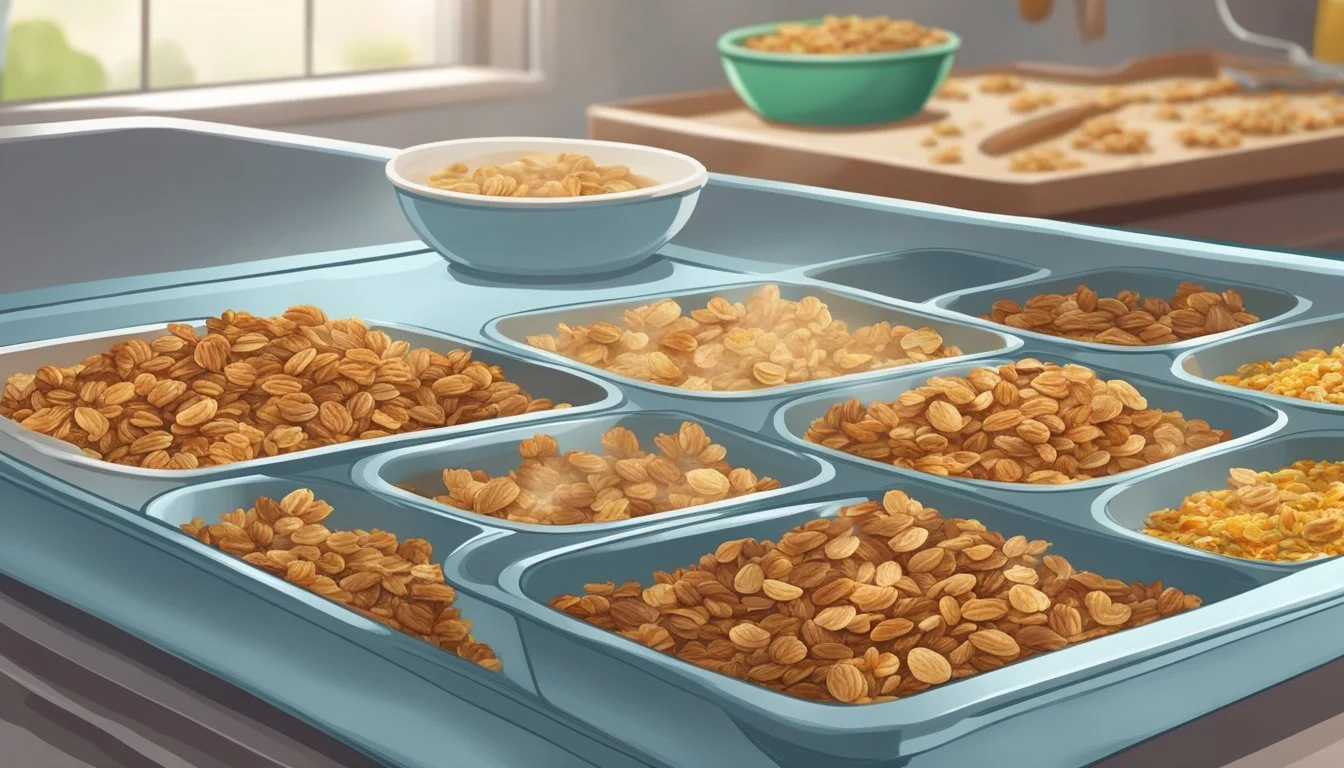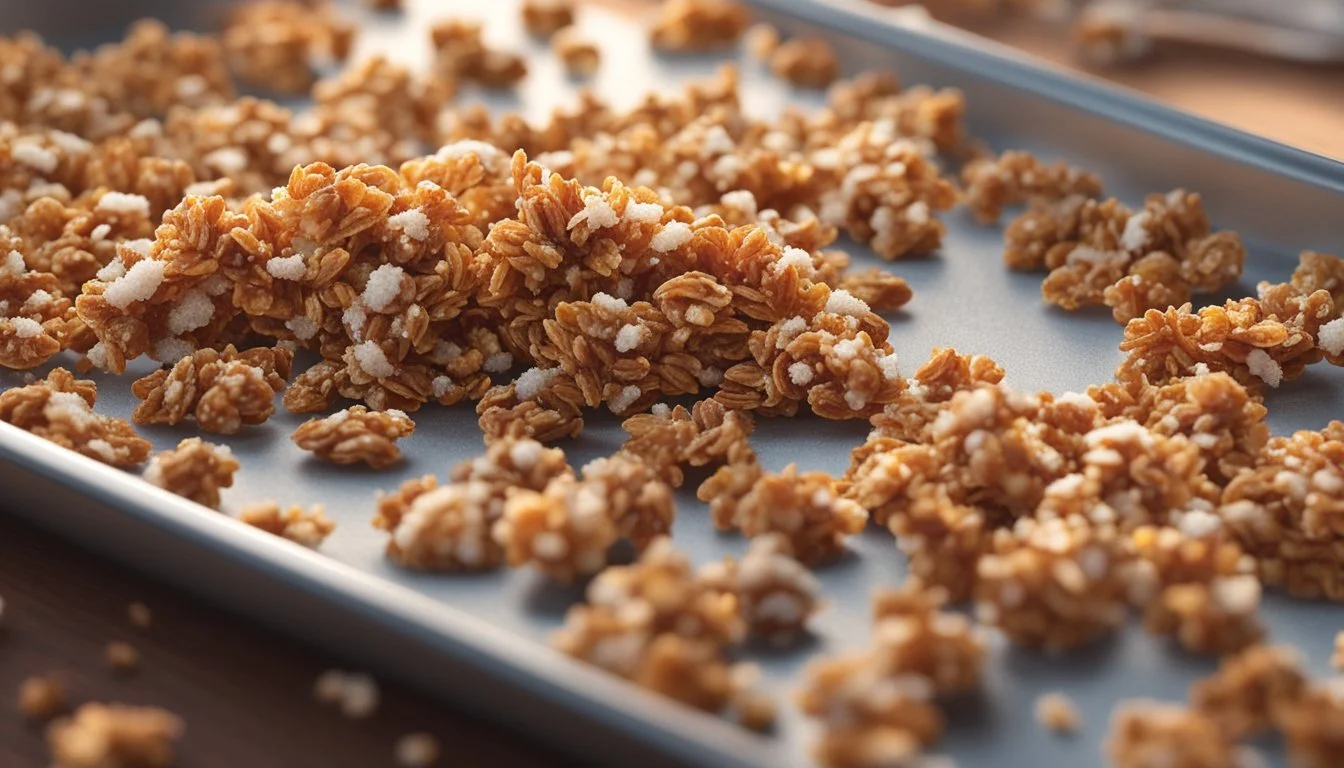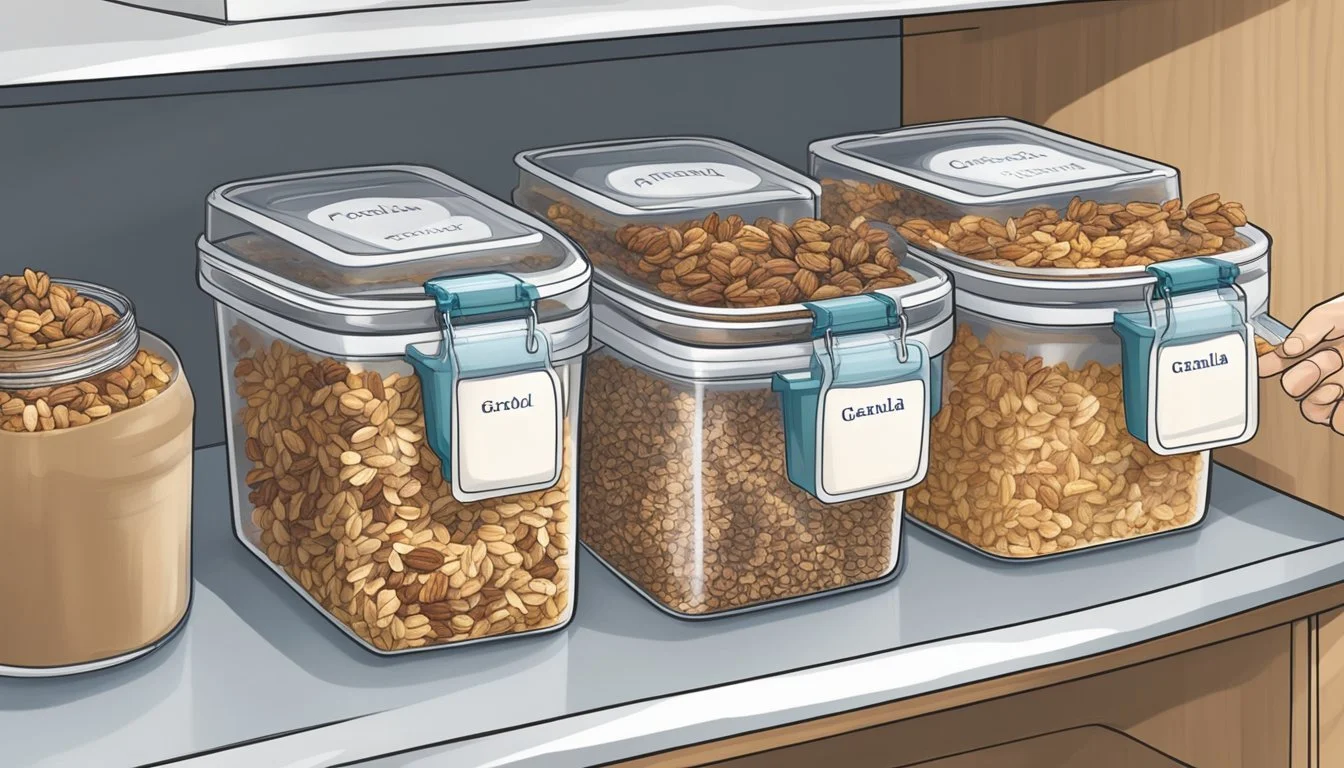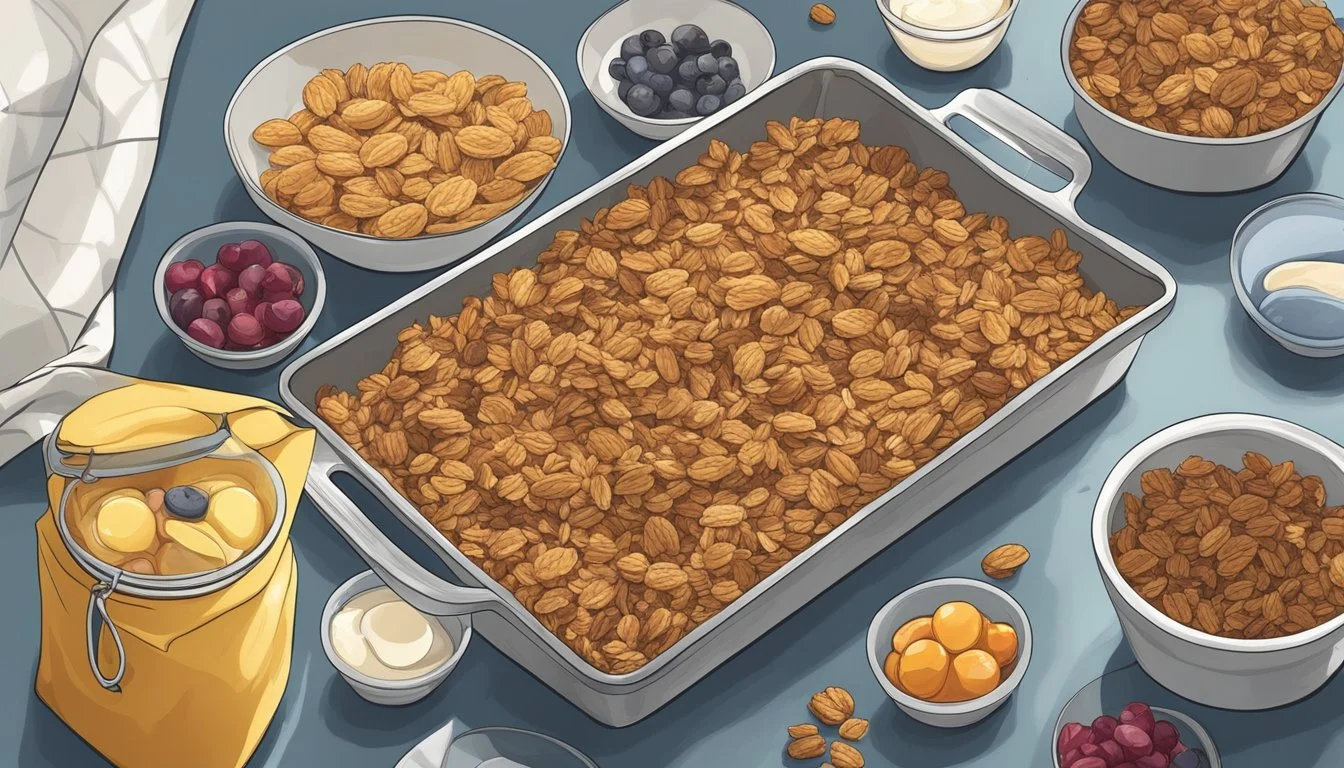How to Freeze Homemade Granola for Crunchy Toppings
Preservation Guide
Freezing homemade granola is an effective way to extend its shelf life while maintaining the crunchy texture and flavor that makes it such a delightful addition to a variety of dishes. Granola is an incredibly versatile food, commonly enjoyed as a breakfast item with yogurt or milk, or as a snack on its own. It's packed with whole grains, nuts, and seeds, providing a wholesome crunch that's both satisfying and nutritious. However, its shelf life at room temperature can be limited, particularly once the package is opened and the granola is exposed to air.
Storing homemade granola in the freezer is a straightforward process that prevents the oats and nuts from becoming stale and the dried fruits from losing their quality. By keeping granola at a consistently low temperature, it remains fresh for much longer periods. This practice is not only convenient but also economical, allowing granola enthusiasts to prepare larger batches without worrying about spoilage. The key to successfully freezing granola lies in ensuring it is completely cool before packaging, dividing it into desired portions, and using airtight containers or freezer bags to minimize exposure to air and moisture.
Understanding Granola Basics
When it comes to granola, one must appreciate the versatility of its ingredients and the potential health benefits that come with its thoughtful consumption. Understanding the basic composition and nutritional value of granola is essential for appreciating this popular food item.
Ingredients and Flavor Profiles
Granola typically consists of a mixture of oats, nuts, seeds, and dried fruit, often bound together with a sweetener like honey or maple syrup. This combination not only creates a crunchy texture but also a rich flavor profile that can range from sweet to savory, depending on the ingredients used.
Common ingredients in granola:
Oats: Provide a hearty base and are a great source of fiber.
Nuts: Almonds, walnuts, and pecans add crunch and healthy fats.
Seeds: Pumpkin, sunflower, and flax seeds offer additional texture and nutrients.
Dried fruit: Raisins, cranberries, or apricots infuse sweetness and chewiness.
Sweeteners: Honey or maple syrup provide natural sweetness and help bind granola.
These ingredients can be mixed and matched to create various flavor combinations, ensuring that granola can be tailored to individual tastes and dietary preferences.
Health Benefits of Granola
Granola can be a nutritious option, particularly when it is homemade and ingredients are carefully chosen. Its main components bring several health benefits:
Oats: A good source of soluble fiber, which can help with digestion and heart health.
Nuts and Seeds: Rich in protein and healthy fats, they contribute to feelings of fullness and provide essential fatty acids.
Dried Fruit: Offers natural sweetness and a dose of vitamins, although it can also add sugar content.
It's important to be mindful of the sweeteners and oils used in granola, as these can increase the calorie content. By controlling the amount of added sugar and choosing healthy oils, like coconut or olive oil, granola can be a part of a balanced diet.
Making Your Own Granola
Crafting homemade granola allows one to control the quality and variety of ingredients. It also ensures that the granola is as crispy, crunchy, and full of clusters as preferred.
Selecting Quality Ingredients
The foundation of any granola recipe lies in selecting high-quality, fresh ingredients. It is essential to choose old-fashioned or rolled oats as they provide the best texture. For nuts and seeds, one should opt for raw and unsalted varieties, and ensure they are fresh to avoid a rancid taste. Dried fruits should be void of added sugars and preservatives to maintain a natural flavor profile.
Granola Recipe Essentials
The essential components of a homemade granola recipe include:
Oats: One should use old-fashioned rolled oats for optimal texture.
Nuts and Seeds: A mix of almonds, walnuts, pumpkin seeds, or sunflower seeds introduces a rich source of nutrients and crunch.
Sweeteners: Natural sweeteners like honey or maple syrup not only bind the granola together but also contribute to the overall flavor.
Oil: A necessary ingredient to help crisp up the granola. Coconut oil is a popular choice for its subtle sweetness.
One assembles these ingredients in a balance that suits their taste preference.
Baking Techniques
Proper baking techniques are crucial to achieving the perfect crunch. One must:
Preheat the oven to a moderate temperature between 250°F to 300°F to ensure even baking.
Spread the mixture thinly on a parchment paper-lined baking sheet to prevent sticking and for easy cleanup.
Stir the granola every 15 minutes to promote even browning and crispy clusters.
Bake until it is a deep golden brown, which usually takes 45 minutes to an hour.
The granola should be allowed to cool completely on the baking sheet to crisp up before storing or eating.
Preparing Granola for Freezing
Ensuring granola retains its texture and flavor during freezing requires proper cooling and packaging. These steps help maintain its crispness and prevent moisture from affecting the quality.
Cooling Before Freezing
Before one can place granola in the freezer, it is imperative to let it cool down completely after it has been baked. Cooling serves two main purposes. First, it prevents condensation from forming when the granola is packaged, which could lead to a soggy texture. Second, it helps maintain the granola's crispness, a key quality for a satisfying crunch. The granola should be spread out in a thin layer on a baking sheet to allow even and quick cooling.
Packaging Granola Properly
Once the granola is cool, proper packaging is crucial for preserving its quality in the freezer. It should be placed in an airtight container to keep out moisture and other contaminants that could affect its dry, crisp nature. Options for airtight containers include:
Mason jars: ideal for portion control and reusable.
Ziploc bags: convenient for squeezing excess air out before sealing.
Freezer-safe containers: designed to withstand low temperatures and prevent freezer burn.
When using bags, one should ensure all the air is pressed out before sealing to minimize the risk of freezer burn. Each package should be clearly labeled with the date of freezing to keep track of how long it has been stored.
For those preferring an eco-friendly approach, reusable silicone bags or beeswax wraps are alternative options that also provide the necessary airtight seal. Always store these containers or bags in a flat position to optimize space and preserve the granola's shape and texture.
The Freezing Process
To maintain the crunchiness and extend the shelf life of homemade granola, precise steps should be followed in the freezing process to avoid moisture content changes that could lead to freezer burn or ice crystallization.
Freezing Granola Correctly
When freezing granola, individuals need to ensure the granola is completely cooled to room temperature to prevent condensation which can contribute to ice crystal formation. The granola should then be divided into desired portions to allow for easy use after freezing without needing to defrost the entire batch.
Packaging: Use airtight containers or heavy-duty freezer bags to minimize the granola's exposure to air.
Expelling Air: Remove as much air as possible from the bags to reduce the risk of freezer burn.
Labeling: Clearly label the package with the content and the freezing date to keep track of its age in the freezer.
How Long to Freeze Granola
The shelf life of granola in the freezer can typically range from three to five months. It is important to:
Maintain Consistent Temperature: Keep the freezer at a constant temperature to prevent temperature fluctuations that might cause granola to soften.
Storage: Store the packaged granola in the back of the freezer where temperature changes are minimal compared to the door area.
Use: To enjoy granola at its best, one should use it within the optimal storage timeframe and allow it to thaw at room temperature for a short period before serving.
Thawing and Re-Crunching Granola
To maintain the quality of granola after freezing, one must thaw it correctly and re-crisp it to restore its freshness and crunch. Proper techniques help prevent sogginess and preserve taste.
Thawing Granola Safely
Room Temperature Thawing: Granola should be thawed at room temperature to ensure even warming and to prevent condensation. Remove it from the freezer and let it sit in its airtight container for a few hours before opening.
Avoid Condensation: To protect the granola's texture, avoid exposing it to air immediately after removal from the freezer, as condensation can make the granola soggy.
Re-crisping After Freezing
Using the Oven: Preheat the oven to a low heat, around 275°F (135°C). Spread the granola in an even layer on a baking sheet, and warm it for 5 to 10 minutes.
Preserve Crunchiness: This gentle reheating will drive off any moisture that may have been trapped during freezing, ensuring that the granola returns to a crispy, crunchy state.
Cooling Down: Allow the granola to cool completely at room temperature before storing it again in an airtight container to retain its newly restored crispness.
Creative Uses for Frozen Granola
Frozen granola is a versatile ingredient that can be a crunchy addition to many breakfasts and desserts. Its convenience and delicious flavor make it an excellent choice for a quick and satisfying meal or treat.
Breakfast Options
For a quick breakfast, frozen granola can be used straight from the freezer. It adds a delightful crunch when sprinkled over yogurt, making for a nutritious start to the day. Those with a little more time can layer it with fruits and yogurt to create a parfait. For a heartier option, they can serve it with milk as a cereal or blend it into a smoothie for added texture.
Yogurt Topping: Simply sprinkle frozen granola on top of yogurt.
Granola Parfait: Layer yogurt, fruits, and granola for a nutritious meal.
Granola Cereal: Combine with milk for an instant cereal.
Smoothie Addition: Blend into smoothies for extra crunch.
Snacks and Desserts
Frozen granola is not just for breakfast; it serves as a great topping for various snacks and desserts. It can be a crunchy addition to ice cream or frozen yogurt for a delectable treat. People can also use it in baking; adding it to homemade fruit crisp recipes not only enhances the flavor but also contributes texture to the dessert. Granola even works well as a standalone snack; it’s convenient to grab and eat for those on the go.
Ice Cream Sprinkle: Enhance the texture of ice cream with a sprinkle of granola.
Baking Ingredient: Include in recipes for fruit crisps for a crunchy texture.
Convenient Snack: Enjoy granola by itself for a nutritious and delicious snack.
Storing Granola Long-Term
When considering the long-term storage of homemade granola, maintaining its crunch and freshness is paramount. The reader will learn about effective storage methods that preserve granola's quality over time and how to recognize when granola has gone bad.
Best Practices for Storage
Location: For long-term storage, granola should be kept in a cool, dry place such as a pantry or cupboard. Keeping it away from heat sources and light minimizes the risk of spoilage.
Containers: To store granola, use airtight containers as they prevent moisture and air from compromising the granola's texture and flavor.
Refrigerator: While room temperature is sufficient for short-term, storing granola in the refrigerator can extend its shelf life, especially in warmer climates.
Freezer: For maximum longevity, freezing granola is highly effective. Granola can remain fresh for up to 6 months when stored properly in the freezer.
Labeling: Always label containers with the date of storage. This helps track how long the granola has been stored and manage consumption while it's still at its best quality.
Identifying Spoilage
Granola can go bad, so it's important for individuals to know how to identify when it's no longer suitable for consumption.
Smell and Taste: If granola emits a rancid or off smell, which indicates that the oils within it have gone bad, it should not be consumed.
Texture: A change in texture to a chewy or soggy consistency is a telltale sign that granola has absorbed moisture and should be discarded.
Mold: Visible signs of mold growth are a definite indicator of spoilage and present a health risk if consumed.
Troubleshooting Common Issues
When freezing homemade granola, one aims to preserve its crunchy texture while preventing any deterioration in quality. Two common problems may arise: granola becoming soggy and the risk of freezer burn. The following subsections provide guidance on how to address these issues effectively.
Dealing with Soggy Granola
Cause: Soggy granola is often the result of excess moisture, which can be introduced during the cooling or packing process.
Solution:
Cool Thoroughly: Ensure that the granola is completely cool before packing it for the freezer. This prevents condensation from forming, which can lead to a soggy texture.
Pack Smart: Use air-tight containers or vacuum-sealed bags to protect against moisture ingress.
Preventing Freezer Burn
Risk: Over time, granola stored in the freezer may suffer from freezer burn, which occurs when air comes into contact with the food, leading to dehydration and oxidation.
Mitigation Strategies:
Reduce Air Exposure: Remove as much air as possible from the packing container or bag before sealing.
Proper Containers: Store granola in sturdy, freezer-grade containers to act as a barrier against the cold air.
Consistent Temperature: Keep your freezer at a steady temperature to minimize the risk of texture changes due to temperature fluctuations.
Granola Beyond the Freezer
When one decides to store granola long-term, the freezer isn't the only viable option. Granola enthusiasts can explore alternative storage solutions and methods to ensure a supply of crunchy, delicious toppings is always at hand.
Refreshing Your Granola Supply
In the event that granola has been stored for a while and begins to lose its characteristic crunch, refreshing the granola can restore its appeal. To rejuvenate granola, an individual can spread it on a baking sheet and warm it in an oven preheated to 275°F for a few minutes. Monitoring closely prevents burning, and once cooled, the granola will regain its satisfying texture.
Alternative Storage Solutions
To maintain granola's texture without freezing, proper storage is key. Granola should be kept in an air-tight container to protect it from moisture and preserve its crunchiness. Ideal alternatives include:
Glass Jars – They are excellent for visibility of contents and maintain freshness. Ensure the lids seal tightly.
Plastic Storage Containers – These should be used provided they can seal out air effectively.
Granola Bars – If one prefers a more portable option, they can press granola into bars and wrap them individually for easy storage and snack accessibility.
Regardless of the choice, storing granola in a cool, dry place such as a pantry will help extend its shelf life and keep it ready for a variety of uses, from yogurt toppings to baking additions.











